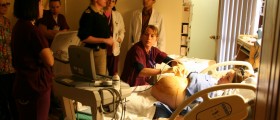
A neural tube defect (NTD) is a common birth defect that occurs early in fetal development, between 20 and 28 days of gestation. It is actually a group of disorders characterized by incomplete development of the brain and spinal cord. Exact cause of NTDs is unknown but it is believed that combination of environmental and genetic factors are responsible for their occurrence.
A neural tube defect develops when the cells of the neural plate in an embryo fail to form a narrow tube called the neural tube. This tube represents a stage of normal fetal development of the back bone and the spinal cord. Since the neural tube does not close completely, the brain and spinal cord remain exposed and unprotected, thereby vulnerable to damage. The most common types of neural tube defects are anencephaly and spina bifida.
Anencephaly
Anencephaly is the most severe form of NTDs. In this disorder, most of the brain does not develop because the head end of the neural tube fails to close. Infants with anencephaly have incomplete skulls and lack the forebrain and cerebrum. Affected babies are usually blind, deaf and unconscious. They may be stillborn or live only a few hours or days after birth.
Spina Bifida
Spina bifida, the most common type of NTDs, occurs when the neural tube fails to close completely at the caudal extremity resulting in underdeveloped spine and spinal cord. Infants with spina bifida have an opening in their back through which the spinal cord protrudes. Severity of the disorder may range from mild to severe and result in partial or complete paralysis and other problems such as learning disabilities, gastrointestinal disorders and bowel or bladder problems. Spina bifida can be also accompanied by hydrocephalus (fluid on the brain). Affected infants are commonly surgically treated which prevents further damage to the nervous system.
Prevention of Neural Tube Defects
According to scientific studies, sufficient intake of folic acid before and during pregnancy can prevent neural tube defects. Folic acid (vitamin B9) also called folate or folacin is a water-soluble vitamin found in green leafy vegetables like spinach, broccoli and lettuce as well as fruits such as bananas and melons. Orange juice, egg yolks, beans, mushrooms and fortified breakfast cereals are also rich in folic acid.
Folic acid is a coenzyme essential for many bodily functions. It promotes cell division and growth in infancy and pregnancy. Its deficiency may result in many problems in developing embryo thus daily folic acid requirements are higher during pregnancy than usual.
Pregnant women and women who are planning to get pregnant should get 400 micrograms of folic acid in addition to natural forms of folic acid obtained from foods.

















Your thoughts on this
Loading...